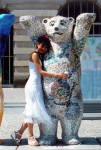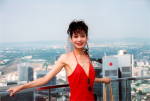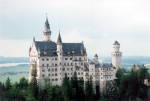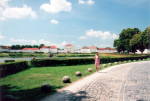In July 2006, Rosa and I traveled to Germany. We were there during the World Cup soccer finals, although we did not stay in any city that was currently hosting a match – we were there either before or after the matches in each city. This has been our only trip where we rented a car to drive from city to city.
We arrived in Berlin, and as is our habit, we went to the hotel and had a nap to acclimatize to the time zone. Our hotel was in the former East Berlin; the area was noticeably different from the formerly western-controlled areas. It was more run-down. Behind our hotel was a field where a marooned circus wagon was being used as a shelter.
After our nap, we got up and went out for supper. There was a nearby restaurant with a nice patio. A projection TV was set up on the patio for everyone to watch the World Cup Quarter Finals. We had a nice dinner while watching the match. A crowd formed on the sidewalk to watch the match.
 Our first day out in the city started with a visit to the Reichstag building. This is the seat of Germany government. It is a very symbolic part of Germany’s history. In 1933, the Reichstag was burned, which the Nazi’s blamed on the Communists, leading to an overt persecution of Communists in Nazi Germany. It also allowed the Nazi’s to suspend most personal rights. The end of World War II in Europe was when the Russian troops took the Reichstag after 2 intense days of fighting within the building. It remained in that state until the reunification of Germany. Today it has been refurbished, but the scars of World War II are easy to see on the building – massive number of bullet holes on parts that have remained as they were at the end of the war.
Our first day out in the city started with a visit to the Reichstag building. This is the seat of Germany government. It is a very symbolic part of Germany’s history. In 1933, the Reichstag was burned, which the Nazi’s blamed on the Communists, leading to an overt persecution of Communists in Nazi Germany. It also allowed the Nazi’s to suspend most personal rights. The end of World War II in Europe was when the Russian troops took the Reichstag after 2 intense days of fighting within the building. It remained in that state until the reunification of Germany. Today it has been refurbished, but the scars of World War II are easy to see on the building – massive number of bullet holes on parts that have remained as they were at the end of the war.
On the roof, architect Norman Foster added a glass cupola. Below it is the debating chamber for the German parliament. A circular sun block is mounted in the cupola, and it rotates to follow the sun, to prevent the light from dazzling the parliamentarians below. The glass allows daylight to provide the light for the chamber, reducing the electricity costs. It is also open to the weather to symbolically allow dissemination of ideas and debates between the people of Germany and the government.
After the Reichstag, we walked through Brandenburg Gate into former East Berlin. The gate was a focal point for both superpowers during the Cold War. The gate was being refurbished when we visited, which meant we could not get a very good picture of the impressive gate.
We continued along Unter den Linden Boulevard, stopping for a drink at Starbucks (what better symbol of the fall of the Soviet Union than a Starbucks in East Berlin) then continuing to take pictures at Lustgarden, Berliner Dom (Berlin Cathedral) and Humboldt University. The plaza across from Humboldt is known as Bebelplatz. In 1933, 20,000 books were taken from the library of Humboldt and burned in Bebelplatz by the Nazi’s. Today, at the location of the fire is a glass panel in the ground, open to a room under the plaza where you can just make out empty bookshelves that could hold 20,000 books. There is a very somber plaque there with an inscription from Heinrich Heine: “That was only a prelude; where they burn books, they ultimately burn people”.
 Also in this square was a circle of bear statues, each one uniquely painted and decorated, and representing one of the countries of the world. We were not sure if it was part of the World Cup celebration. We took pictures with the Canada Bear.
Also in this square was a circle of bear statues, each one uniquely painted and decorated, and representing one of the countries of the world. We were not sure if it was part of the World Cup celebration. We took pictures with the Canada Bear.
The next day, we went to the western parts of Berlin. We stumbled upon the Helmut Newton Foundation, which housed an incredible gallery of his photographic works. It was a great discovery and we spent a couple of hours looking around.
After a quick bite to eat, we visited the Berlin Zoo. Rosa was thrilled to see the polar bears, as she loves polar bears.
The next day, we went to the uniquely designed Jewish History museum. The museum told the history of Jews in Germany, with a particular focus on the horrors of The Holocaust. A few of the rooms had no exhibits but were designed to create a horrible scene for foreboding and dread – big empty, irregularly shaped rooms with a single window high up along one wall.
 After the Jewish History museum, we walked over to Checkpoint Charlie. This was an important border crossing between East and West Berlin, manned by the Americans. This was the site of major Cold War confrontations. Nearby was the Checkpoint Charlie Museum, which had some of the original Berlin Wall segments.
After the Jewish History museum, we walked over to Checkpoint Charlie. This was an important border crossing between East and West Berlin, manned by the Americans. This was the site of major Cold War confrontations. Nearby was the Checkpoint Charlie Museum, which had some of the original Berlin Wall segments.
Later in the day, we travelled back to the west, where we walked along the shopping streets near the Berlin Zoo. Our destination was KaDeWe (Kaufhaus des Westens), which is the second largest department store in Europe (after Harrod’s). We wanted to eat in the food areas on the top floors. It is rumored that KaDeWe has 1,800 varieties of cheese for sale, and this was also a draw for us.
The next day we left for Frankfurt. We had reserved a car for our trip. I was hoping for something nice and European like an Opel or Audi. Instead, when we arrived I was disheartened to find that it was a Chevy Lacetti. Sigh. But it did have a 5-speed manual transmission. We had printed out our driving instructions from Google. Getting out of the city was painless, and once on the Autobahn, the driving was very easy. I was able to cruise around 140 to 150kmph. In construction zones and in certain towns are actual speed limits, and apparently there are also limits when it is raining, but for the most part it was up to me to set whatever pace I wanted. Sweet!
Getting into Frankfurt was more difficult. We had a lot of difficulties finding our hotel, and we ended up driving around in a circle over and over again. The street names were not clearly marked, and, the same street might change names every block.
Our hotel in Frankfurt-am-Main was walking distance to everything we wanted to see, starting with the shopping area of Zeil. This is apparently the busiest shopping street in Europe. It is a pedestrian street with, lined with department stores and shops, with large plazas at each end. Rosa had the opportunity to do lots of shopping along the Zeil.
 At one end of the Zeil shopping area is the Main Tower, which has an observation platform on the roof. We went up to look around and take some pictures. After that, we stumbled upon the Alte Oper, a former opera house. It was nearly destroyed in World War II, but has been restored and is used for concerts (but not operas). On our way back, we walked through the picturesque old city center, Römer square, which was the site of the City Hall (Rathaus) from 1405.
At one end of the Zeil shopping area is the Main Tower, which has an observation platform on the roof. We went up to look around and take some pictures. After that, we stumbled upon the Alte Oper, a former opera house. It was nearly destroyed in World War II, but has been restored and is used for concerts (but not operas). On our way back, we walked through the picturesque old city center, Römer square, which was the site of the City Hall (Rathaus) from 1405.
In the evening, we stopped for dinner in an outdoor café at the eastern end of the Zeil and stayed to watch the first Semi-Final World Cup match on TV. It was neat to be there, as there were visitors from all over the world stopping at the café to watch. It was fun to see people interact during the game when they often didn’t speak a common language (or both defaulted to a few words of English).
The next day we walked to the other side of the Main River. The weather in Frankfurt was hot and humid. We stumbled upon the Deutsches Filmmuseum and went in, but after about 45 minutes, we had to leave so that we could get some fresh air. Rosa felt so sick – it really scared me. Once she had something to drink in the shade, she started feeling better.
We continued along to our destination, the Bible Museum, which Rosa had suggested. We thought it could provide context and information on the historicity of the book; the bible was built up over the centuries, and comprised of four separate books that do not always agree with each other. Instead, it had a fake boat where Christians can sit around with each other and sing, an 8-foot tall bible you can walk into and baskets of spices that could have been used in the time of Jesus. It was entirely a waste of our time.
But that’s ok, because the next place we went, the Fotografie Forum Frankfurt photography museum, was my selection and it was equally disappointing. The only exhibit at the photography museum was a series of photos of kids around Europe playing soccer (in honor of the World Cup, of course). I was hoping to see something like Annie Leibovitz or other famous photographers who have had installations in the past.
On our final evening in Frankfurt, we watched the second Semi-Final World Cup match in our hotel room – we were too tired to go out. For at least an hour after the match, people were in the street celebrating, and honking their car horns.
The next day we drove to Munich. On a straight southbound stretch, I was able to take the car up to 180kmph for about 10 minutes. I felt save doing so, as there were basically no cars around. We had less difficulties getting to our hotel in Munich, although the changing street names did confuse us again. Our hotel in Munich was across from the main train station and subway, and walking distance to many interesting sites.
 We went out to walk around, and Rosa could do more shopping along another pedistrian shopping street near our hotel. We went into the Residenz, an Art Museum in a former palace. Much of the museum dates to the 16th Century. At the end of the day, we stopped at a beer hall near Marienplatz; Rosa had white sausage (weisswurst) and I had pretzels. Neither of us drinks beer. I had wanted to see the famous Rathaus-Glockenspiel, but we missed the 5:00pm chime.
We went out to walk around, and Rosa could do more shopping along another pedistrian shopping street near our hotel. We went into the Residenz, an Art Museum in a former palace. Much of the museum dates to the 16th Century. At the end of the day, we stopped at a beer hall near Marienplatz; Rosa had white sausage (weisswurst) and I had pretzels. Neither of us drinks beer. I had wanted to see the famous Rathaus-Glockenspiel, but we missed the 5:00pm chime.
 The next day Rosa and I visited two very romantic castles built by King Ludwig II of Bavaria, which were about 90 minutes drive southwest of Munich. The first was Hohenschwangau, which was where Ludwig II grew up. We took a horse-buggy ride up to the castle, although we later walked down from the site, past a lovely lake. From this castle, you can see the second, better-known castle of Neuschwanstein. Neuschwanstein is absolutely fabulous and breathtaking, situated on the side of a mountain. It was a hard walk to get up to the castle, so we took our time and rested on the way up the side of the mountain. Neuschwanstein was one of the inspirations of Sleeping Beauty’s Castle in Disneyland.
The next day Rosa and I visited two very romantic castles built by King Ludwig II of Bavaria, which were about 90 minutes drive southwest of Munich. The first was Hohenschwangau, which was where Ludwig II grew up. We took a horse-buggy ride up to the castle, although we later walked down from the site, past a lovely lake. From this castle, you can see the second, better-known castle of Neuschwanstein. Neuschwanstein is absolutely fabulous and breathtaking, situated on the side of a mountain. It was a hard walk to get up to the castle, so we took our time and rested on the way up the side of the mountain. Neuschwanstein was one of the inspirations of Sleeping Beauty’s Castle in Disneyland.
The next day, we stayed in Munich. First we visited the Deutsches Museum, which is one of the worlds largest technical and science museums. There was much to see – so many shiny things! Eventually we got on the subway and went out to the Olympiapark from the 1972 Olympics. Along the way into the Park, we stopped at the BMW Museum. It was only a temporary museum, as BMW was building a new one across the street, next to their world headquarters. At the end of the day, we debated if we should stay in the Olympic Park to watch the World Cup final with the huge crowd that was beginning to form. But we were both exhausted, so we went back to the hotel and watched on TV.
 The next day, we took our final road trip of our Germany tour. We drove to Berchtesgaden, about 2 hours southeast from Munich, the site of Kehlsteinhaus (Eagle’s Nest), a chalet built by the Nazi’s in the Alps and given as a gift to Adolf Hitler. The views were spectacular, but the history of the place, combined with the mountain air gave me the chills. The view was spectacular though.
The next day, we took our final road trip of our Germany tour. We drove to Berchtesgaden, about 2 hours southeast from Munich, the site of Kehlsteinhaus (Eagle’s Nest), a chalet built by the Nazi’s in the Alps and given as a gift to Adolf Hitler. The views were spectacular, but the history of the place, combined with the mountain air gave me the chills. The view was spectacular though.
 Next, we visited the wonderful palace of Nymphenburg, on the outskirts of Munich. We spent most of the day wondering around the grounds and the palace. They were quite breath-taking.
Next, we visited the wonderful palace of Nymphenburg, on the outskirts of Munich. We spent most of the day wondering around the grounds and the palace. They were quite breath-taking.
On our last day, we went to the site of the concentration camp of Dachau. This was not an extermination camp like the ones in Eastern Europe, although as many as 25600 people died there mostly as a result of disease and malnutrition. This was a very sad place.
The next morning, we drove ourselves to the Munich airport and flew back home. Our trip in Germany was really wonderful, with the excitement of the World Cup, planning our trips for the rental car, and the time we spent together.
Our photo gallery: http://gallery.myredbmw.net/v/Travel/Germany2006/ (password protected).
The Google Earth file of our trip is here: Germany 2006.kmz.

One Reply to “Germany, July 2006”